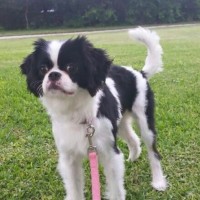Appearance of the Cava-Chin
|
| The Cava-Chin is generally quite small. Ultimately, this will depend on the dominant genes of the parents, but this hybrid usually weighs no more than 8 kilos and measures around 30.5 centimeters high at the shoulder. Females tend to be slightly larger than their male counterparts. Its hair will generally be of medium to long length. Occasionally, it may have wavy or curly hair. It can have a variety of colors, but often will be modeled much like the parent Cavalier King Charles Spaniel breed. It can be white with brown, red, fawn or black markings. It's also important to know the Japanese Spaniel's appearance to determine what the Cava-Chin might look like. The Japanese Spaniel actually comes in a variety of shapes and sizes due to the introduction of different breeds into the gene pool over the years. Some Chin are significantly larger than their counterparts. Your Cava-Chin may have a broad head with large, wide eyes and a flat, brachycephalic face, meaning the muzzle is short. Their ears are small and V-shaped, with long hair covering them. These dogs have an underbite. The tail may be curled over the back with feathered hairs along the tail. The coat, if similar to the Japanese Spaniel, could be white with colored patches, the most common colors being black, red, lemon, orange, sable, black and white with brown or brindle points. Without a standard for the Cava-Chin hybrid, your pet may take on characteristics inherited from either parent. Either way, he'll be adorable. |
Temperament of the Cava-Chin
|
| The Cava-Chin is a very gentle dog. He's energetic and lively. He is most certainly a companion dog, although with a sense of humor and a mischievous temperament, he may have a talent for pursuing his own interests. He has a great memory and remembers well anyone who disturbs him in any way. He loves people and likes to be surrounded by his family; Cava-Chins can experience separation anxiety. He needs reinforcement with treats and other positive measures during training. He is known for obeying commands and listening to his owner. It has a reputation for being playful and energetic with children, as well as being very affectionate. The Cava-Chin is an excellent dog for novice owners. |
Needs and activities of the Cava-Chin
|
| The Cava-Chin is a lively, playful little dog. However, he needs a minimum of thirty minutes of daily exercise to prevent him from having pent-up energy, which could lead him to be destructive. Dog parks are recommended for the Cava-Chin, as it will certainly enjoy interaction with other dogs. If you don't have a dog park in your area, perhaps he could accompany you on a walk or jog. Leaving your Cava-Chin outside in an unfenced yard is not recommended, nor is leaving it unattended. It has a reputation for chasing cars, so if you're outside with it, it should be on a leash or in a fenced-in area. It's also important not to put too much strain on your Cava-Chin. It's always possible that the Cava-Chin inherits the brachycephalic muzzle of its Japanese Spaniel parent. If this is the case, overheating can lead to breathing difficulties for the Cava-Chin. |
Maintenance of the Cava-Chin
|
| Cava-Chins have moderate grooming requirements. It's not difficult to maintain, but grooming really depends on the type of coat it inherits. Generally, the Cava-Chin doesn't shed as much as its Cavalier King Charles Spaniel relative. He will need to have his coat brushed with a pin brush at least once a week. If he needs a bath, be sure to remove tangles and mats from his coat before wetting him, otherwise the tangles will be almost impossible to remove. During shedding season, daily care may be the best idea. Nail and tooth care are also important, as the Cava-Chin can be prone to tooth decay like all small canine breeds. If his nails make a clicking sound when he walks, then his nails should be trimmed immediately. |









 English (United Kingdom)
English (United Kingdom)